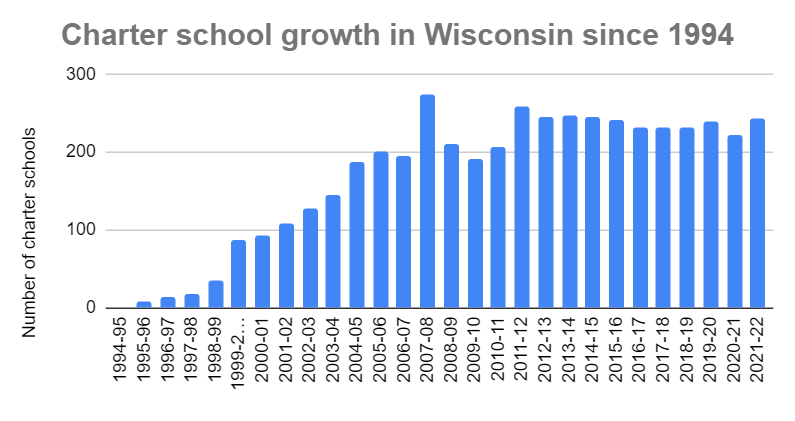Here's what charter schools are and how they work in Wisconsin
What are charter schools?
Charter schools are public schools that are granted freedom from most state regulations. They may experiment with different curriculum, schedules and ways of learning, with the idea that traditional public schools can adopt methods that are found successful.
As public schools, they must be nonreligious and not charge tuition. They must be open to all students and use a lottery system if they cap enrollment, with preference in some cases for neighborhood students, siblings of current students, and children of the founders, leaders or staff of the school. They are required to serve students with disabilities.
Who runs charter schools?
Charter schools may be run by school districts, nonprofit corporations or for-profit corporations.
To launch and receive public funds, charter schools must secure a contract, or “charter,” from a school board or other designated authorizer, such as the Milwaukee Common Council, UW Chancellors or technical college boards. Those authorizers set expectations in the contract, monitor the schools’ performance and can end contracts if schools fall short.
School districts can authorize charter schools as "instrumentality" or "non-instrumentality" schools. Instrumentality charter schools are run by school district employees while non-instrumentality charter schools are run by independent corporate boards of directors. Other authorizers cannot operate instrumentality charter schools.

What exactly can charter schools do differently than other public schools?
Charter schools are exempt from most state requirements for other public schools (Wisconsin state statute chapters 115 through 121), from what they teach to how they teach it.
Those requirements are far-ranging and include: teaching certain subjects in certain grade levels, providing a minimum number of teaching hours, starting the school year after Sept. 1, teaching about Indigenous tribes, ensuring reading materials reflect cultural diversity, providing supplies for students who can't afford them, adopting and sharing bullying policies, informing staff of resources for suicide prevention, and ensuring an opt-out for families who don't want to follow uniform dress codes.
Additionally, if charter schools have trouble filling jobs with licensed teachers, they can have applicants get a special charter school license if they have a bachelor’s degree and pass an exam related to the content they will teach.
At charter schools not run by school districts, the teachers are not unionized with the district staff and generally are not unionized at all. The schools don’t have to publish salary minimums for teachers or share salary data with the state.
With more flexibility, charter schools may focus more on project-based learning, bilingual immersion, online classes, Montessori methods, arts or other specialties.
Where did charter schools come from?
The concept is traced to Ray Budde, an education professor at the University of Massachusetts Amherst, who suggested in the 1970s that school districts could grant contracts to groups of teachers who wanted to operate with more curriculum flexibility.
Democratic lawmakers in Minnesota were the first to write charter schools into law in 1991, with a twist. While Budde imagined charter schools operating as part of public school districts, the state law opened the door for teacher-led nonprofits to operate charter schools with approval from school districts. They were funded directly by the state.
Wisconsin was one of seven states to follow close behind, welcoming charter schools in 1993 under Republican Gov. Tommy Thompson — without the requirement that teachers lead them. Wisconsin started with a cap of 20 schools statewide and required authorization from local school boards and the state superintendent. Since then, the cap has lifted and charter schools can receive authorization from other entities instead.

Are charter schools growing?
The number of charter schools in Wisconsin increased every year until hitting 231 in 2007, and has since stabilized around that number.
Total enrollment in charter schools continued growing, hitting a new peak in the 2020-21 school year with about 51,000 students — about 6% of all Wisconsin students — attending charter schools, according to a report from the state Department of Public Instruction.
Nationwide, the number of charter schools has grown every year, with the National Alliance for Public Charter Schools reporting a total 7,821 charter schools in the 2020-21 school year with 3.7 million students.
How are charter schools funded and how do they affect school districts?
For a charter school authorized by an entity other than a school board, the school receives funding directly from the state, at a per-student amount set by the state budget. The school can also tap into additional state and federal funding streams for certain purposes like special education, and the authorizer can collect a fee for oversight costs.
For a charter school authorized by a school district, all funds flow through that district, which then provides the funding to the charter school.
In the case of Milwaukee Public Schools, the district has funded its internal ("instrumentality") charter schools in the same way it funds any other district school. For independently run ("non-instrumentality") charter schools, the district first provides a per-student amount equal to what non-district-authorized schools get directly from the state. But when it comes to ferrying out funding from other special revenue streams, like special education, the district may hang onto some funds by arguing it provides those services itself to the schools. That can lead to some disagreement, as highlighted in a 2018 Wisconsin Policy Forum report.
As the forum's report also explores, the overall financial impact of non-instrumentality charter schools on school districts is complicated. On one hand, MPS gets to collect some funds for charter school students which the district might be without if those students were instead in private or other non-district schools. On the other hand, the students could otherwise be in MPS-run schools, and the district would have discretion over more funds.
What are the arguments for and against charter schools?
The push for charter schools in the early ‘90s was intertwined with advocacy for state-funded vouchers for private schools, under an umbrella idea of giving parents more choices. Black leaders like Democratic lawmaker Polly Williams and former MPS superintendent Howard Fuller were instrumental in this movement, which came as integration measures for traditional public schools had largely failed; white students moved to suburbs, private schools and specialty schools, taking wealth with them. If white and higher-income students had so many choices, these leaders argued, so should all students.
Decades later, with segregation and inequities still extreme in Milwaukee, 2022 polling suggested Black Democrats in Milwaukee County were somewhat more likely to support charter schools than not, though movements for charter school expansion are largely funded and driven by conservatives. Proponents argue that charter schools bring competition for traditional public schools, encourage innovation and produce higher test scores or college enrollment rates. Some accuse public school districts and their teachers of pushing leftist messaging in curriculum.
Those who oppose independently operated charter schools argue the schools pull resources away from school districts, as state funding largely follows the student. They point out that charter schools tend to serve fewer students with disabilities, leaving other public schools with comparatively higher special education costs. Teachers unions have also opposed independently operated charter schools as the staff are cut off from the union for district staff.
Some who oppose independently operated charter schools say all charter schools should be district-run, which would mean keeping funding in the district, staff under district unions, and more direct accountability to elected officials. Milwaukee Public Schools operates five charter schools under that model.
In 2022, Republicans in the state Legislature passed bills that would have created a new state board that could authorize charter schools as well as required all authorizers to allow charter school operators to open more schools if they received high marks from the DPI.
Democratic Gov. Tony Evers vetoed the bills, arguing they would “usurp the local authority of elected school board members.”
How do I learn more if I’m interested in a charter school?
The Wisconsin Resource Center for Charter Schools operates a directory of charter schools and a guide for enrollment.
You can explore data about schools, like test scores and graduation rates on the state Department of Public Instruction’s WISEdash portal. For schools chartered by school districts, filter for the district and then the school name. For independent charters, the school name will be the district name. Similar information is available on the DPI's report cards.
Contact Rory Linnane at rory.linnane@jrn.com. Follow her on Twitter at @RoryLinnane.
Our subscribers make this reporting possible. Please consider supporting local journalism by subscribing to the Journal Sentinel at jsonline.com/deal.
DOWNLOAD THE APP: Get the latest news, sports and more
This article originally appeared on Milwaukee Journal Sentinel: What are charter schools, how to find charter schools in Wisconsin

